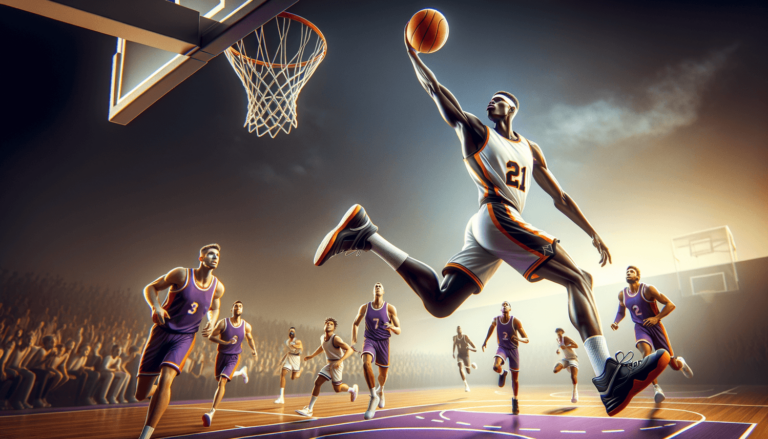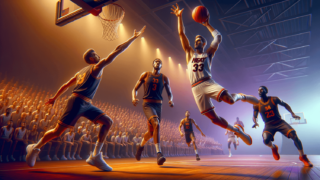
A Successful Basketball Player Has a Height Of…
Written by: Basketball Universe
Last updated:

At first glance, you might think that basketball is a tall player’s game, and to some extent, you’d be right! Towering giants have dominated the sport, leaving folks to wonder about the magical number when it comes to the ideal height in basketball. In this blog post titled ‘A Successful Basketball Player Has a Height Of…‘, we’re going to delve into the fascinating world of roundball and explore if there really is a perfect height range for optimal performance. Get ready to have your misconceptions challenged, as we discover that size isn’t always everything in the captivating realm of hoops!
A Successful Basketball Player Has a Height Of…
While height can be beneficial in basketball, success in the sport is not solely determined by it. Players of various heights have found success at different positions, with the right combination of skills, athleticism, work ethic, and basketball IQ. A successful basketball player’s height can range from under 6 feet, like Muggsy Bogues, to well over 7 feet, like Shaquille O’Neal, so there isn’t a single, definitive height for success.
Challenging the Height Stereotype
Basketball has long been associated with tall athletes. However, as the game evolves and takes on different dynamics, height alone is no longer the only ingredient for success. Skills such as shooting, passing, rebounding, defense, and more are essential for players to excel on the court. In this post, we’ll explore the various heights of successful basketball players and debunk the myth that only towering athletes can rule the sport.
The Height Factor and Positions
Height is undoubtedly an advantage in certain aspects of the game, particularly for centers and power forwards. However, players’ roles on the court have diversified over the years, and smaller players have carved out their own niches in the sport. To understand how height influences each position’s demands, let’s break down the common positions in basketball and examine the influence of height.
Point Guards: The Floor Generals
Point guards are traditionally the smallest players on the team, often around 6 feet tall. They are responsible for managing the offense, setting up plays, and acting as extensions of the coach on the court. Elite point guards excel at ball-handling, passing, and penetrating defenses. Some of the game’s most successful point guards, such as Chris Paul and Steph Curry, are under 6’3″.
Shooting Guards: The Scorers
Shooting guards, often ranging from 6’3″ to 6’7″, primarily focus on scoring. They need a solid shooting stroke, quickness for slashing to the basket, and a high basketball IQ to find gaps in the defense. Notable shooting guards, like Michael Jordan and Kobe Bryant, were taller than their point guard counterparts but still within the aforementioned height range.
Small Forwards: The Swiss Army Knives
Small forwards are versatile players who can contribute to various aspects of the game. They generally stand between 6’6″ and 6’9″ and often possess a balanced mix of speed, ball-handling, shooting, and defensive ability. Players like LeBron James and Kevin Durant have revolutionized the position with their unique skill sets and make a strong case for the impact of height at this position.
Power Forwards: The Bruisers
Power forwards are typically more physical, standing between 6’8″ and 6’11”, and are known for their rebounding and interior scoring. Their height advantage is useful for battling on the boards and protecting the rim. Past players like Karl Malone and Tim Duncan have cemented the importance of a strong power forward in championship-caliber teams.
Centers: The Towers of the Paint
Centers are usually the tallest players on the team, measuring over 7 feet tall. They use their height advantage to block shots, grab rebounds, and score high-percentage buckets close to the rim. Legendary big men like Shaquille O’Neal, Hakeem Olajuwon, and Kareem Abdul-Jabbar exemplify the significance of height at this position.
Size Isn’t Everything: The Rise of the Small Ball
While height still plays an important role in basketball, the shift towards so-called “small ball” lineups has demonstrated that size isn’t everything. Many teams now prioritize speed, shooting, and versatility over traditional height advantages, resulting in more balanced and dynamic squads.
An Exciting Shift in Game Strategies
Small ball lineups emphasize perimeter shooting, faster pace of play, and increased ball movement. This shift has opened the door for players of varying heights to make their mark in the league. The Golden State Warriors, led by Steph Curry and Klay Thompson, ushered in the small ball era of the NBA, which led to multiple championships and a revolution in basketball strategy.
Positionless Basketball: The New Norm
The modern NBA often features positionless basketball, where players’ roles and responsibilities are no longer determined strictly by their height. Talented athletes are expected to excel in various aspects of the game regardless of their size. Players like LeBron James, Giannis Antetokounmpo, or Draymond Green, who can play multiple positions and contribute at both ends of the floor, exemplify this trend.
Exceptional Players Break the Mold
History is filled with examples of basketball players who have defied expectations and excelled despite not fitting the height stereotype of their position.
Big Men with Sharpshooter Skills
Tall players with a devastating shooting touch have become more common in recent years. Dirk Nowitzki, Kristaps Porzingis, and Kevin Durant are great examples of players who have defied the traditional “big man” role and excelled from beyond the arc. These unique athletes showcase that height and shooting expertise can coexist in one outstanding package.
Small Players with Big Impacts
On the other end of the spectrum, smaller players have proven that they can emerge as influential playmakers and scorers. Examples include Isaiah Thomas, Allen Iverson, and Nate Robinson, who have all displayed remarkable scoring abilities and fearlessness on the court. Muggsy Bogues, the shortest player in NBA history—standing at just 5’3″—enjoyed a successful 14-year career and is a testament that exceptional talent transcends height barriers.
The Factors Beyond Height
While height plays a role in basketball, it is not the only factor that contributes to success. Many aspects of the game can make an athlete stand out on the court and make up for any height inadequacies.
Skill Development and Versatility
A robust skill set is critical for excelling in basketball. Players need to hone their shooting, ball-handling, passing, rebounding, and defense abilities to maximize their impact on the court. Versatility, the capacity to adapt to multiple positions and roles, has become increasingly important in the modern game.
Athleticism and Speed
Physical athleticism and speed can help overcome height differences. Players with exceptional quickness, agility, and leaping ability can often out-perform taller opponents. This is evident in explosive athletes like Russell Westbrook and Derrick Rose, who have distinguished themselves with their athleticism.
Work Ethic and Dedication
Hard work and dedication can make up for many deficiencies, including height. Players who are committed to their craft will find ways to excel on the court despite potential disadvantages. Success stories like Stephen Curry and Jimmy Butler, who surpassed scouts’ expectations through a relentless work ethic, exemplify the power of dedication.
Basketball IQ: The Mental Game
Understanding the intricacies of the game is essential for every player, regardless of their height. The ability to read and react to play developments, efficiently utilizing teammates, and strong decision-making skills are critical components of the mental aspect of basketball. Players like Chris Paul, Steve Nash, and Larry Bird have proven that a high basketball IQ can lead to extraordinary success.
The Height of Success: A Relative Concept
So, what is the height of a successful basketball player? The answer is not as straightforward as it might seem. As we’ve explored, height plays a role in basketball, but it’s not the only factor that determines an athlete’s success. With the right mixture of skills, athleticism, work ethic, and basketball intelligence, players of various heights can excel in the sport. Basketball is a game of skill, heart, and determination—a reality that no height stereotype can eclipse.
Success Stories of Undersized and Oversized Players
While we have touched upon a few exceptional player examples in different sections already, it is essential to emphasize that unique success stories exist at various heights, as the sport has consistently produced surprising talent across the spectrum. Let’s take a closer look at these inspiring stories and analyze how they became successful in the game of basketball.
Undersized Victories
Small in stature but big in skill, these undersized players have carved their names in the annals of basketball history through sheer tenacity, perseverance, and talent.
Spud Webb: A Slam Dunk Pioneer
Standing at a mere 5’7″, Spud Webb left an indelible mark on basketball history with his electrifying athleticism. Webb’s most memorable moment came during the 1986 NBA Slam Dunk Contest, where he emerged as the champion, proving that height does not dictate a player’s ability to stun audiences and defy gravity.
Earl Boykins: A Prolific Scorer
Reputed as one of the smallest players in NBA history at just 5’5″, Earl Boykins managed a successful career by showcasing his scoring prowess. He holds the record for the highest-scoring game by a player shorter than 5’6″, notching an impressive 32 points in a single match. Boykins’ story emphasizes how skills matter more than height in the game of basketball.
Oversized Achievements
Utilizing their unique physical attributes, these supremely tall athletes became dominant forces on the court, leaving their own impact on basketball history.
Manute Bol: The Shot-Blocking Legend
Standing at a colossal 7’7″, Manute Bol was one of the tallest players ever to grace the NBA courts. Though offensively-limited, his undeniable shot-blocking abilities made a significant impact on the defensive end. Bol’s towering height made him an effective rim protector, demonstrating that immense size can bring unique advantages to the court.
Gheorghe Mureșan: Tallest NBA Player Ever
Sharing the title of tallest NBA player ever at 7’7″ alongside Manute Bol, Gheorghe Mureșan’s immense size and surprising agility made him a formidable center. Mureșan’s career highlights include winning the NBA’s Most Improved Player award in 1996 while being an influential figure on his team’s playoff run that season. His story illustrates how a blend of height and skill can yield success in basketball.
Cultivating Success: What All Players Can Learn
These extraordinary stories of basketball players with diverse height profiles offer valuable lessons for aspiring athletes of any size. To maximize their chances for success, players should focus on the following:
Master the Fundamentals
Regardless of height, players must develop a strong foundation in fundamental skills such as dribbling, shooting, passing, and defense. These skills will make them valuable assets on any team and allow them to contribute in versatile ways.
Embrace Your Unique Advantages
Every player has unique physical traits and skills that can be utilized effectively on the court. Embrace these individual qualities and learn how to employ them as strengths in gameplay situations.
Teamwork and Communication
Basketball, at its core, is a team sport. The ability to communicate effectively, understand your teammates’ strengths and weaknesses, and sacrifice personal achievements for the team’s success will make any player an invaluable contributor, irrespective of their height.
Never Stop Learning
Great players understand that there is always room for improvement. Constantly analyzing their performance, seeking guidance from coaches, and maintaining an adaptive mindset are crucial facets for growth and long-term success in basketball.
Ultimately, a successful basketball player’s height varies significantly, and the game has provided ample evidence that players of all statures can achieve greatness. By focusing on skill development, embracing unique advantages, and committing to constant growth, players can unlock their fullest potential and defy any height-related stereotypes.
FAQs: Debunking Height-Related Queries in Basketball
Curious about height and its significance in basketball? We’ve got you covered! Here’s a compilation of frequently asked questions focused on clearing up the myths and misconceptions related to height in the sport. Continue reading to gain a deeper understanding of how height ties into a player’s success!
1. What is the average height of an NBA player?
The average height of an NBA player is roughly 6’7″. However, this may vary depending on the position and team. Keep in mind that players of various heights have found success in professional basketball.
2. Do taller players have a higher success rate in basketball?
Taller players often have advantages in specific aspects of the game, like rebounding and shot-blocking. However, success in basketball is not solely determined by height but also skills, athleticism, work ethic, and basketball IQ. Players of different heights have been successful in the sport.
3. Can shorter players excel in professional basketball?
Yes, shorter players can excel in professional basketball. Many undersized players have enjoyed successful careers due to their exceptional skills, determination, and athleticism. Examples include Muggsy Bogues, Isaiah Thomas, and Spud Webb.
4. What is the ideal height for a point guard?
Traditionally, point guards are around 6 feet tall. However, the ideal height is not set in stone, and players with diverse statures have found success as ball handlers and playmakers. The critical aspects for point guards are ball-handling, passing, and leadership skills.
5. How important is height in basketball?
Height can be beneficial in certain aspects of the game, such as rebounding and shot-blocking. However, skills, athleticism, work ethic, and basketball IQ are also crucial factors in determining a player’s success. It’s essential to consider that height alone does not determine a player’s potential.
6. How has the significance of height in basketball evolved?
With the strategic shift towards “small ball” lineups and positionless basketball, height is no longer the only measure of success. Versatility, shooting ability, and athleticism have become increasingly important on both ends of the court, allowing players of varying heights to thrive in modern basketball.
7. Is height important when recruiting basketball players?
Height is often considered during the recruitment process, as taller players may possess natural advantages. However, many coaches and scouts also prioritize skill sets, work ethic, and athleticism, understanding that these qualities may offset any height disadvantages.
8. Are there specific basketball positions ideal for shorter players?
Shorter players generally excel as point guards and shooting guards, as these positions require sharp ball-handling, passing, and shooting skills, which are not always height-dependent. However, some undersized players have succeeded in other positions, demonstrating exceptional athleticism and skill.
9. What factors besides height contribute to success in basketball?
Several factors besides height contribute to success in basketball. These include skill development and versatility, athleticism and speed, work ethic and dedication, and a high basketball IQ.
10. How have taller players adapted to the modern game?
Taller players have adapted to the modern game by expanding their skillsets, focusing on shooting, ball-handling, and agility to fit into versatile “small ball” lineups. Many big men, like Kristaps Porzingis and Kevin Durant, have become efficient perimeter shooters to remain effective in the contemporary game.
11. How can undersized players compensate for their height disadvantage?
Undersized players can compensate for their height disadvantage by focusing on skill development, athleticism, speed, and agility. A strong work ethic, commitment to improving, and mental resilience are also essential for smaller players to overcome height-related challenges.
12. What is the shortest height for a successful NBA player?
The shortest successful NBA player is Muggsy Bogues, who stood at just 5’3″. Bogues had a successful 14-year career in the NBA, defying expectations with his skill, athleticism, and tenacity.
13. What is the tallest height for a successful NBA player?
Manute Bol and Gheorghe Mureșan are the tallest successful NBA players, measuring 7’7″ each. Both players excelled in shot-blocking and capitalized on their height advantage to impact the game on the defensive end.
Featured Posts
- No pillar pages found.





